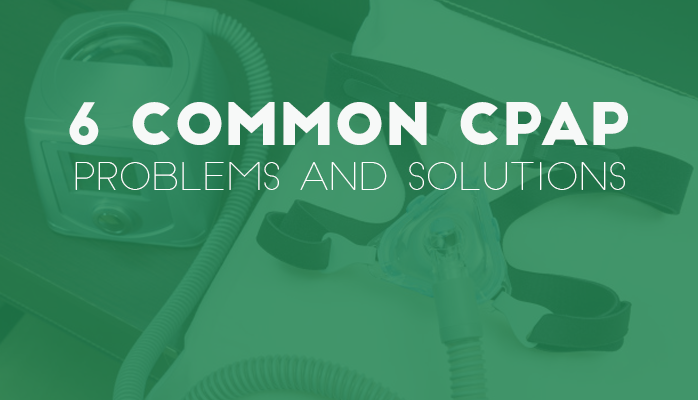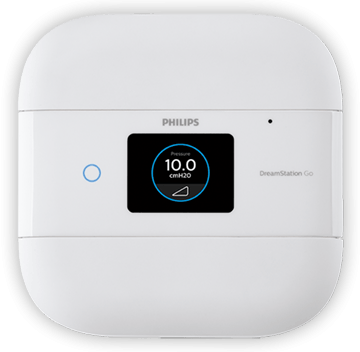
For individuals diagnosed with obstructive sleep apnea who use a CPAP machine on a daily basis, common issues arise that may interfere with quality of therapy. Especially for individuals who are about to, or have just started using a CPAP device, typical problems that CPAP machine users run into are important to know about. Continue reading to learn about 6 common problems and their solutions.
1. Difficulty Falling Asleep
Problem: I'm having trouble getting to sleep wearing the CPAP device.
Solution: Falling asleep with a mask on is certainly an adjustment CPAP users have to make when first transitioning to using the device every night. Many people complain that the mask feels cumbersome and heavy. However, most individuals stop complaining of trouble after experiencing the deep sleep they're able to finally achieve once they begin to successfully operate their device. In order to initially get used to wearing the device, sleep specialists recommend that CPAP users practice wearing the mask while awake to get used to the sensations. Putting on the mask when watching television or reading a book can be a relaxing way to get used to the device. By doing this, new CPAP users will be able to adjust the tension and pressure of their device and effectively utilize it during their hours of slumber.
2. Can't Handle Forced Air
Problem: I can't tolerate the feeling of the extreme pressure into my nose and mouth when the CPAP machine is turned on.
Solution: Many machines have a feature that allows the user to escalate and de-escalate the pressure that streams from the device. This feature allows the CPAP user to start out with lower pressure that gradually increases as he or she sleeps. When this gradual increase occurs, the user doesn't sense it while sleeping allowing for quality shut-eye. Sleep specialists can adjust the rate of the air coming from CPAP machines. Individuals are encouraged to mention this problem to their healthcare provider if it continues to be a bother them when going to bed.
3. Ill-Fitting CPAP Mask
Problem: My CPAP mask feels awkward and uncomfortable.
Solution: If the CPAP mask doesn't fit properly, many first-time CPAP users assume that CPAP therapy isn't for them. However, simple adjustments are usually the only things needed to fix the fit of a mask and encourage restful sleep. It's important to understand that CPAP masks come in many different shapes and sizes to accommodate different-sized faces. Another fix to look into is a nasal pillow that covers less of the face and feels less bulky to some when falling asleep. If a CPAP machine user isn't quite sure how to adjust his or her CPAP mask, consulting with a sleep specialist and getting it professionally fitted will ensure the most comfortable results.

Bulky CPAP devices also may post a problem for traveling,
but travel CPAP/APAP machines like this one are made for portability.
4. Nasal Congestion
Problem: When I wake up after using my CPAP machine, my nose is stuffed up.
Solution: The most common cause of nasal congestion when using a CPAP device is an ill-fitting mask that leaks air. Leaky masks tend to dry out noses and lead to stuffiness upon waking. The first step is for the CPAP user to adjust his or her mask to fit properly. Furthermore, the individual can look into getting a CPAP machine with a heated humidifier. Lastly, the user can use a nasal saline spray to help ease dryness.
5. Dry Mouth
Problem: I wake throughout the night or in the morning with dry mouth after using my CPAP machine.
Solution: CPAP users who are used to breathing with an open mouth and begin using a CPAP device may find that their dry mouth becomes worse. Air leakages can occur and lead to a lack of moisture in the mouth. To solve this problem, a chin strap may assist in keeping the mouth closed and reducing air leakage if a nasal mask is used with the CPAP machine. Chin straps are inexpensive, easy to adjust, and have received positive reviews from users who also experience dry mouth. A heated humidifier is an additional tool that may help in allowing moisture to stay in the mouth during sleep.
6. Continued Snoring
Problem: Even though I'm using my CPAP machine, I'm still snoring at night.
Solution: If an individual who begins using a CPAP device finds that they are still snoring at night, they need to seek professional assistance from their sleep specialist. Snoring should cease to occur for those who are using a CPAP machine. Therefore, CPAP machine users should make sure that their masks fit properly if snoring continues. Other reasons why the machine might not be working properly is if the air pressure is too low or if sleeping position is impacting air flow. Some CPAP users have found better results when sleeping on their side while using their CPAP machine instead of sleeping on their backs.
Conclusions
All in all, the fastest way to guarantee the best results while using a new CPAP machine is by consulting with a medical professional. Professionals like the sleep specialists at the Anchorage Sleep Center can help to solve any CPAP therapy related problems that a CPAP user may be experiencing.
If you suspect that you may have obstructive sleep apnea and are interested in CPAP therapy or are seeking a sleep consultation, send a message to a specialist online to get answers and achieve your best possible sleep.

